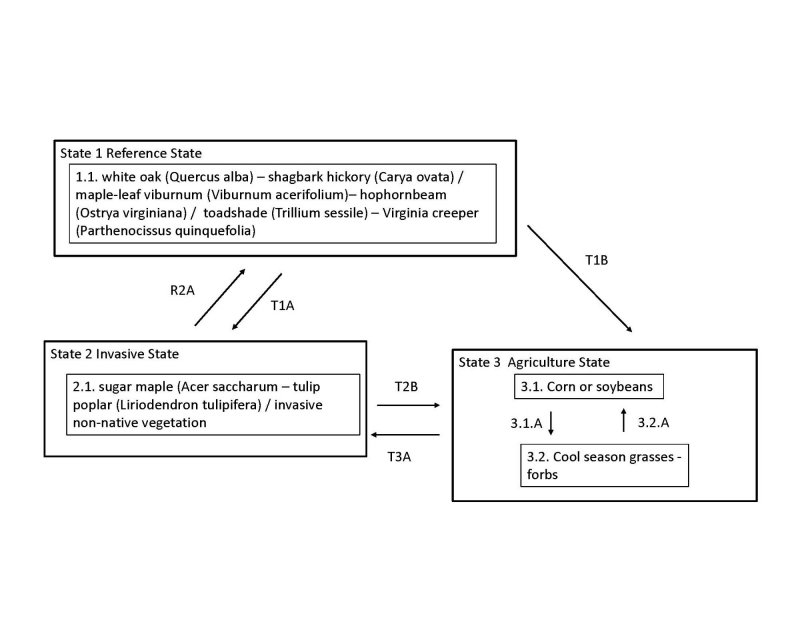
Natural Resources
Conservation Service
Ecological site F114XA504IN
Sloping Till Upland Forest
Last updated: 9/26/2024
Accessed: 01/02/2025
General information
Provisional. A provisional ecological site description has undergone quality control and quality assurance review. It contains a working state and transition model and enough information to identify the ecological site.
MLRA notes
Major Land Resource Area (MLRA): 114X–Southern Illinois and Indiana Thin Loess and Till Plain
MLRA 114A makes up about 4,550 square miles (11,795 square kilometers). The three parts of this MRLA are mostly in the Till Plains Section of the Central Lowland Province of the Interior Plains. The western third of the western part is in the Highland Rim Section of the Interior Low Plateaus Province of the Interior Plains. The eastern half of the eastern part is in the Kanawha Section of the Appalachian Plateaus Province of the Appalachian Highlands. Both large and small tributaries of the Ohio River dissect the nearly level to very steep glaciated uplands in this area. The major streams and rivers have well defined valleys with broad flood plains and numerous stream terraces. The flood plains along the smaller streams are narrow. Broad summits are nearly level to gently sloping. Elevation ranges from 320 feet (100 meters) on the southernmost flood plain along the Ohio River to 1,250 feet (380 meters) on the highest ridges. Local relief is mainly 10 to 50 feet (3 to 15 meters), but it can be 50 to 100 feet (15 to 30 meters) along drainageways and streams. Also, the Ohio River bluffs are as much as 300 feet (90 meters) above the river valley floor.
Classification relationships
USFS: 222 Eastern Broadleaf Forest (Continental) Province
Homoya's Natural Regions of Indiana: Bluegrass Region
The following NatureServe Explorer Ecological System has a high level of probability to match the ecological site found on these soils:
Southern Interior Low Plateau Dry-Mesic Oak Forest- Unique Identifier: CES202.898.
North-Central Interior Dry-Mesic Oak Forest and Woodland- CES202.046
Ecological site concept
The Sloping Till Upland Forest reference community is a mature mixed hardwood forest with an oak component. Multiple tree species may share dominance on these sites including white oak, hickory, black walnut, sugar maple, basswood, northern red oak, white ash,. Other species include eastern black cherry, American elm, beech, and tulip poplar. Quality sites will have a wonderfully diverse understory community of native herbs and forbs, including an array of native spring wildflowers.
Few high-quality, old-growth communities remain. Agriculture is the largest use of these soils in MLRA 114A. Most sites have incurred repeated disturbances including selective harvest (oak removal), clearing, grazing, invasive species and absence of natural fire regimes. Disturbance will transition this community to a woodland dominated by fast-growing, shade-tolerant species such as sugar maple, tulip poplar, white ash, and beech. The resulting dense canopy shade on these sites often results in a more sparse understory community.
Associated sites
| F114XA502IN |
Till Uplands These sites are generally lower on the landscape and less well drained. |
|---|
Similar sites
| F114XA305IN |
Non-Acidic Upland Forest This group is a well-drained oak-hickory forest but is on limestone residuum and/or limestone and calcareous shale. |
|---|
Table 1. Dominant plant species
| Tree |
(1) Quercus alba |
|---|---|
| Shrub |
(1) Viburnum acerifolium |
| Herbaceous |
(1) Trillium |
Click on box and path labels to scroll to the respective text.
Ecosystem states
| T1A | - | Disturbance; invasion of non-native species |
|---|---|---|
| T1B | - | Tree clearing; brush and weed control; planting of desire species; agricultural management |
| R2A | - | Brush control; weed control; planting of desired species; continual management inputs |
| T3A | - | Abandonment |
State 1 submodel, plant communities
State 2 submodel, plant communities
State 3 submodel, plant communities
| 3.1.A | - | Site preparation; tillage; seeding; weed control; grassland management |
|---|---|---|
| 3.2.A | - | Site preparation; tillage; seeding; weed control; row crop management |


